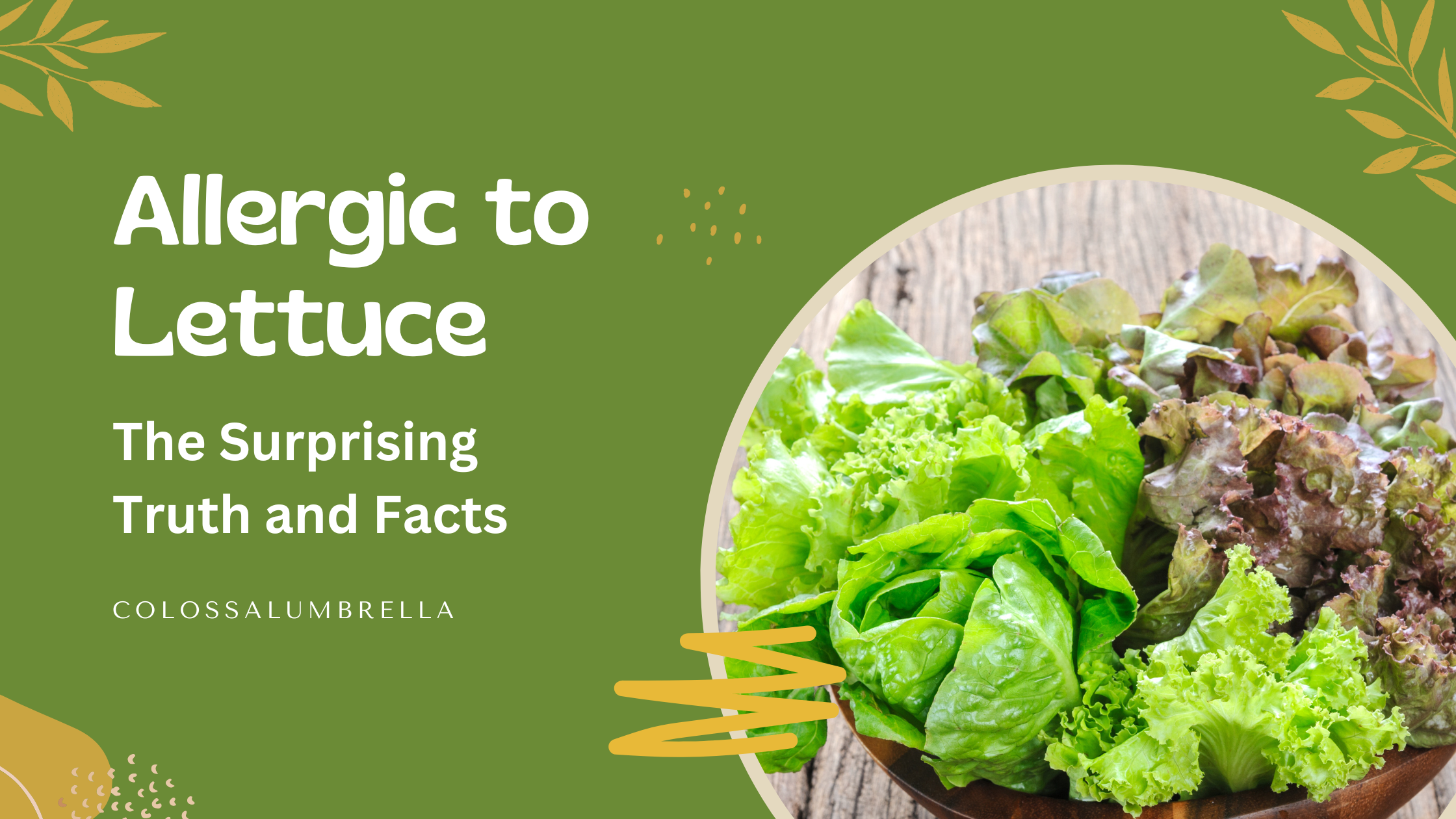Allergic to lettuce? You’re not alone. Lettuce allergies, specifically to romaine and iceberg lettuce, are not uncommon, and can cause adverse reactions ranging from mild digestive upset to life-threatening anaphylactic shock. Lettuce, a popular leafy greens, is often consumed raw, making it a prime trigger for those with food allergies or pollen food allergy syndrome.
Oral allergy syndrome, which causes an itchy mouth and throat after consuming raw vegetable and fruits, is also associated with lettuce allergies. This condition is more common in young children but can affect individuals of any age.
Although lettuce is often thought of as a healthy food, those with lettuce allergies must avoid it altogether. This can be challenging since lettuce is a common ingredient in many salads and other dishes.
If you suspect you may have a lettuce allergy, it’s important to speak with your doctor and get tested for food allergies. With proper diagnosis and management, those with lettuce allergies can still enjoy a healthy and balanced diet while avoiding potential allergic reactions.
What is a lettuce allergy?
A lettuce allergy is a type of adverse reaction that can occur when consuming edible leaves, specifically raw lettuce. Some individuals may develop this allergy after consuming too much lettuce, which can trigger an immune response. The proteins in lettuce can be the trigger for the allergic reaction, and some people may also be sensitive to a group of proteins found in salad dressings.
Symptoms of lettuce allergies can range from mild to severe and include digestive issues like food poisoning, such as stomach cramps, bloating, and diarrhea. In some cases, people with a lettuce allergy may experience a severe allergic reaction that can lead to anaphylaxis. It is crucial to seek medical attention immediately if anaphylaxis is suspected.
If you suspect that you have a lettuce allergy, it is essential to avoid consuming raw lettuce and other foods that may trigger an allergic reaction. In some cases, individuals with lettuce allergies may be able to tolerate cooked lettuce. However, it is always important to consult with a doctor or allergist for guidance on managing lettuce allergies.
Why do some people develop a lettuce allergy
It is not clear why some people develop a lettuce allergy, while others do not. Like other food allergies, it is thought to be a combination of genetic and environmental factors. If you have a family history of allergies, you may be more likely to develop a lettuce allergy. Other risk factors include exposure to pesticides or other chemicals used in the production of lettuce, as well as a weakened immune system.
Common foods that contain lettuce
Lettuce is a common ingredient in many foods, particularly salads and sandwiches. It is also used as a garnish in many dishes. Some common foods that may contain lettuce include:
- Caesar salad
- Greek salad
- Chef salad
- BLT sandwich
- Turkey club sandwich
- Hamburger
- Tacos and burritos
- Wraps
- Spring rolls
If you have a lettuce allergy, it is important to read food labels carefully and ask questions about the ingredients in dishes when dining out.
Diagnosing a lettuce allergy
If you suspect that you may have a lettuce allergy, it is important to see a doctor for a proper diagnosis. Your doctor may perform a skin prick test, where a small amount of lettuce extract is placed on your skin and then pricked with a needle. If you are allergic to lettuce, you will develop a red, itchy bump at the site of the test.
Blood tests may also be used to diagnose a lettuce allergy. Your doctor may also recommend an elimination diet, where you avoid all foods that contain lettuce for a period of time and then slowly reintroduce them to see if the symptoms return.
Managing a lettuce allergy – Tips and Tricks

If you have been diagnosed with a lettuce allergy, it is essential to manage the condition properly to avoid triggering an allergic reaction. Here are some tips and tricks to help you manage your lettuce allergy:
- Avoid Raw Lettuce: If you have a lettuce allergy, it is essential to avoid consuming raw lettuce. Cooked lettuce may be tolerated by some people, but it is still essential to be cautious and check for any possible symptoms.
- Read Labels: Always check food labels to ensure that they do not contain any lettuce or lettuce-based products. This includes salad dressings, which often contain lettuce proteins.
- Inform Others: Inform your family members, friends, and co-workers about your lettuce allergy to avoid any accidental exposure. Make sure that they understand the severity of your allergy and what to do in case of an emergency.
- Carry an EpiPen: In case of anaphylaxis, carry an EpiPen with you at all times. This auto-injector contains epinephrine, which can help reverse the symptoms of a severe allergic reaction.
- Alternative Greens: Replace lettuce with other leafy greens, such as spinach, kale, or arugula, to ensure that you are still getting your daily dose of greens.
- Consult with an Allergist: If you have a lettuce allergy, it is essential to consult with an allergist to develop a management plan. They can provide you with advice and guidance on how to avoid lettuce and other trigger foods, as well as prescribe medication to help manage symptoms.
- Substitute Lettuce: If you miss the crunch and texture of lettuce in your salads, try substituting it with other greens, such as spinach, kale, arugula, or collard greens. These greens are all nutrient-dense and can be just as tasty as lettuce.
- Experiment with Dressings and Toppings: To add flavor and variety to your salads, try experimenting with different salad dressings and toppings. There are many allergy-friendly options available that do not contain any lettuce-based products.
- Cook Your Greens: Cooking your greens can help reduce the risk of an allergic reaction. Steaming, sautéing, and roasting are all good options. These methods break down the proteins in the greens, making them easier to digest.
- Take an Antihistamine: Consider taking an antihistamine before eating greens to reduce the severity of your symptoms. Antihistamines work by blocking the effects of histamine, which is released during an allergic reaction.
Alternative greens for those with a lettuce allergy
If you have a lettuce allergy, you may be wondering what greens you can eat instead. The good news is that there are plenty of delicious and nutritious alternatives to lettuce, including romaine lettuce, biennial lettuce, and other lettuce varieties. However, if you are allergic to the group of proteins found in lettuce, such as LTP syndrome, you may also need to avoid other raw fruits and low FODMAP vegetables.
Fortunately, there are still many options available. Spinach, for example, is a great source of important nutrients like iron, calcium, and vitamin K. Kale is another nutrient-dense green that is loaded with vitamins and minerals, including vitamins A, C, and K, and calcium. Both spinach and kale can be eaten raw or cooked.
Arugula is another alternative to lettuce that is packed with vitamin C and potassium. It has a bold, spicy flavor that pairs well with strong dressings and toppings. Collard greens are also a good option, providing calcium, iron, and vitamin C. They have a slightly bitter flavor and can be eaten raw or cooked.
If you are unsure which greens to eat, you can talk to your doctor or allergist about getting a skin prick test or an IgE antibody allergy test, which can help identify any other potential allergies. Additionally, if you have IBS symptoms or experience abdominal pain after eating certain foods, you may want to consider avoiding certain salad dressings that contain high amounts of olive oil or lac-s. Lastly, if you are an older child or adult with severe symptoms, your doctor may recommend a blood sample to further evaluate your allergy.
Living with a lettuce allergy – stories from those who have it
Living with a food allergy can be challenging, but it is possible to live a healthy and fulfilling life with the right strategies in place. Here are some stories from people who have a lettuce allergy and how they manage their symptoms:
- “I always make sure to read food labels carefully and ask questions when dining out. I also carry an EpiPen with me at all times, just in case.”
- “I substitute lettuce with other greens in my recipes and experiment with different dressings and toppings to keep things interesting.”
- “I love kale salads and find that they are a great substitute for lettuce. I also cook my greens to reduce the risk of an allergic reaction.”
- “I always make sure to have an antihistamine on hand in case of an allergic reaction.”
Talking to your doctor about a potential lettuce allergy
If you suspect that you may have a lettuce allergy, it is important to talk to your doctor. They can perform tests to diagnose the allergy and provide you with strategies for managing your symptoms. Here are some tips for talking to your doctor about a potential lettuce allergy:
- Be honest about your symptoms and how they are affecting your daily life.
- Ask questions about the testing process and what to expect.
- Discuss strategies for managing your symptoms and staying healthy.
- Make sure to follow up with your doctor regularly to monitor your allergy and adjust your treatment plan as needed.
Conclusion – the importance of food allergy awareness
Food allergies are a serious and potentially life-threatening issue that affect millions of people worldwide. While lettuce allergies may not be as common as other food allergies, they can still cause a range of allergic symptoms that can make mealtime a challenge. It’s important to learn about the symptoms and strategies for managing a lettuce allergy so that you can stay safe and healthy while still enjoying a varied and nutritious diet.
People with lettuce allergies should be cautious of consuming particular foods that may trigger an allergic reaction. Foods that are high in fiber, such as cruciferous vegetables, can be problematic due to their low fiber content. When a person with a lettuce allergy ingests a food allergen, their immune system may overreact and trigger an allergic reaction, which can include abdominal pain, skin rashes, or even anaphylaxis.
To manage a lettuce allergy, it’s important to be vigilant when reading food labels and to ask questions when dining out. It’s also a good idea to talk to your doctor if you suspect that you may have a lettuce allergy. They may recommend an ige antibody allergy test or skin prick tests to determine the severity of your food allergy reaction. With the right strategies in place, you can live a healthy and fulfilling life, even with a food allergy.
I would stay connected and keep you updated with parenting tips, pregnancy guides, creative ideas, easy crafts, and Free Printables. Subscribe to Colossalumbrella to get new ideas delivered to your inbox. Follow me on Facebook, Pinterest, Twitter, and Instagram.
Shop
I would appreciate you support to help me run this blog. I run a small affiliate shop, which means that if you click on the link and make a purchase, I may earn a commission at no additional cost to you.
Disclaimer: The content of this blog is for informational purposes only and is not intended to be a substitute for professional medical advice, diagnosis, or treatment. Always seek the advice of your physician or other qualified healthcare providers with any questions you may have regarding a medical condition.
